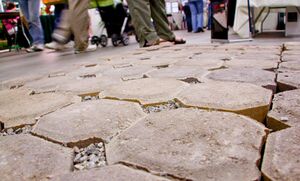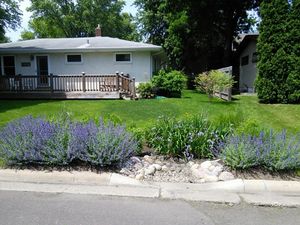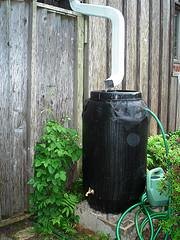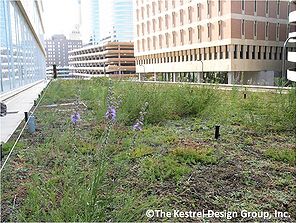
Difference between revisions of "Capturing rainwater and preventing runoff"
| (7 intermediate revisions by the same user not shown) | |||
| Line 1: | Line 1: | ||
| − | == | + | [[File:Pdf image.png|100px|thumb|left|alt=pdf image|<font size=3>[File:Pdf image.png|100px|thumb|alt=pdf image|<font size=3>[https://stormwater.pca.state.mn.us/index.php?title=File:Capturing_rainwater_and_preventing_runoff_-_Minnesota_Stormwater_Manual.pdf_July_2022.pdf Download pdf]</font size>]] |
| + | [[File:K2id-1100-permeablepaver.jpg |right|thumb|300 px|alt=This image shows permeable pavers|<font size=3> Permeable pavers let rain flow straight into the underlying soil</font size>]] | ||
| + | [[File:General information page image.png|left|100px|alt=image]] | ||
| + | [[file:RG pic1.jpg|thumb|300px|alt=photo of a rain garden|<font size=3>Bioinfiltration (rain garden) in a residential development. Photo courtesy of Katherine Sullivan.</font size>]] | ||
| + | [[File:Rainbarrel.jpg|right|thumb|300 px|alt=This image shows a rain barrel|<font size=3> Rain barrel</font size>]] | ||
| + | [[File:Minneapolis Central Library 2nd Floor South Facing Green Roof, Minneapolis, MN.jpg|300px|thumb|alt=image of Minneapolis central Library, Minneapolis, Minnesota|<font size=3> Minneapolis Central Library 2nd floor south facing green roof, Minneapolis, MN. Image Courtesy of The Kestrel Design Group, Inc. </font size>]] | ||
| − | + | When it rains, water can’t soak into impervious surfaces like rooftops, driveways, and roads. Instead, it runs off into streets and storm sewers creating stormwater. From our streets to our streams, stormwater picks up nutrients, dirt, salt, fertilizers, pesticides, oil, bacteria, and garbage. These pollutants can be transported to lakes and rivers. | |
| − | |||
| − | |||
| − | |||
| − | When it rains, water can’t soak into impervious surfaces like rooftops, driveways, and roads. Instead, it runs off into streets and storm sewers creating stormwater. From our streets to our streams, stormwater picks up nutrients, dirt, salt, fertilizers, pesticides, oil, bacteria, and garbage. | ||
Reducing runoff is critical to minimizing the impact our yards and gardens have on the surrounding lakes and streams. There are many ways to encourage rainwater to soak into the ground. Or you can capture rainwater for use in your yard. Either way, stormwater is reduced and our lakes and rivers stay clean. | Reducing runoff is critical to minimizing the impact our yards and gardens have on the surrounding lakes and streams. There are many ways to encourage rainwater to soak into the ground. Or you can capture rainwater for use in your yard. Either way, stormwater is reduced and our lakes and rivers stay clean. | ||
| − | Permeable surfaces: | + | When you are planning changes to your house or lot, think about reducing the size of hard surfaces. For areas where hard surfaces are necessary, consider <span title="Permeable pavements allow stormwater runoff to filter through surface voids into an underlying stone reservoir for temporary storage and/or infiltration. The most commonly used permeable pavement surfaces are pervious concrete, porous asphalt, and permeable interlocking concrete pavers (PICP)."> '''[https://stormwater.pca.state.mn.us/index.php?title=Permeable_pavement permeable pavement]'''</span> that lets water through. There are now a variety of permeable pavements on the market that are specifically designed to increase <span title="Infiltration Best Management Practices (BMPs) treat urban stormwater runoff as it flows through a filtering medium and into underlying soil, where it may eventually percolate into groundwater. The filtering media is typically coarse-textured and may contain organic material, as in the case of bioinfiltration BMPs."> [https://stormwater.pca.state.mn.us/index.php?title=Stormwater_infiltration_Best_Management_Practices '''infiltration''']</span> into the ground. Ask your contractor or home and garden supply store for water-friendly pavers, or porous pavement or asphalt. |
| − | Rain | + | ==Rain gardens and native plants: Beautiful solutions to water pollution== |
| − | + | A rain garden, also called a <span title="Bioretention, also called rain gardens, is a terrestrial-based (up-land as opposed to wetland) water quality and water quantity control process. Bioretention employs a simplistic, site-integrated design that provides opportunity for runoff infiltration, filtration, storage, and water uptake by vegetation. Bioretention areas are suitable stormwater treatment practices for all land uses, as long as the contributing drainage area is appropriate for the size of the facility. Common bioretention opportunities include landscaping islands, cul-de-sacs, parking lot margins, commercial setbacks, open space, rooftop drainage and street-scapes (i.e., between the curb and sidewalk). Bioretention, when designed with an underdrain and liner, is also a good design option for treating Potential stormwater hotspots. Bioretention is extremely versatile because of its ability to be incorporated into landscaped areas. The versatility of the practice also allows for bioretention areas to be frequently employed as stormwater retrofits."> '''bioretention practice'''</span>, is a popular landscaping choice that prevents water pollution by allowing stormwater to soak into the ground before it runs off. Rain gardens and native plants also | |
| − | + | *prevent erosion by holding soil in place with their deep roots, | |
| − | + | *attract birds and butterflies, and | |
| − | + | *require little watering and maintenance once established. | |
| − | |||
| − | |||
| − | * | ||
| − | * | ||
| − | * | ||
Rain gardens are concave gardens that collect runoff from downspouts or driveways. Plants that tolerate "wet feet" should be planted in the bottom, while plants that need less water are planted on the edges. | Rain gardens are concave gardens that collect runoff from downspouts or driveways. Plants that tolerate "wet feet" should be planted in the bottom, while plants that need less water are planted on the edges. | ||
*For information about rain gardens, check out the [http://www.dnr.state.mn.us/gardens/nativeplants/index.html Minnesota Department of Natural Resources] or the [http://www.ci.maplewood.mn.us/1032/Rain-Gardens city of Maplewood] websites. | *For information about rain gardens, check out the [http://www.dnr.state.mn.us/gardens/nativeplants/index.html Minnesota Department of Natural Resources] or the [http://www.ci.maplewood.mn.us/1032/Rain-Gardens city of Maplewood] websites. | ||
| − | *They take a little work to install, but a do-it-yourselfer can do it. Check out the process from start to finish in a short video by [ | + | *They take a little work to install, but a do-it-yourselfer can do it. Check out the process from start to finish in a short video by [https://bluethumb.org/raingardens/ Metro Blooms]. |
*The [http://www.bluethumb.org/raingardens/ Blue Thumb Guide to Raingardens] leads home owners through the steps of designing and installing rain gardens in their yards. Blue Thumb also has a [http://www.bluethumb.org/plants/ Plant Selector Tool]. Simply enter in the conditions of your yard—shady or sunny, wet or dry—and the tool will create a list of native plants that will grow well in those conditions. | *The [http://www.bluethumb.org/raingardens/ Blue Thumb Guide to Raingardens] leads home owners through the steps of designing and installing rain gardens in their yards. Blue Thumb also has a [http://www.bluethumb.org/plants/ Plant Selector Tool]. Simply enter in the conditions of your yard—shady or sunny, wet or dry—and the tool will create a list of native plants that will grow well in those conditions. | ||
*Attend a [http://metroblooms.org/workshops/ Metro Blooms raingarden workshop]. | *Attend a [http://metroblooms.org/workshops/ Metro Blooms raingarden workshop]. | ||
| − | + | ==Rain barrels== | |
| − | + | Another way to reduce runoff is to capture some of it with rain barrels. Rain barrels also help conserve water. They can be fancy or simple, but the basic structure is to have a barrel at the end of a downspout. The barrel has a spigot or hose that you can use to water your garden or yard. Several home improvement stores now sell rain barrels. | |
| − | |||
| − | |||
| − | |||
| − | |||
| − | |||
| − | |||
| − | |||
| − | |||
| − | |||
| − | |||
| − | + | In Minnesota, rain barrels will need to be disconnected during winter so that they don't freeze and crack. To winterize your rain barrel, | |
| + | #disconnect the downspout from the rain barrel and re-connect a downspout extension to the main downspout to funnel water away from the foundation of the house, | ||
| + | #empty the rain barrel, and | ||
| + | #flip the rain barrel upside-down and store it outside, or, if you have room, move the rain barrel into a garage or basement. | ||
| − | + | ==Green roofs== | |
| + | Another way to reduce runoff and the amount of impervious surfaces on your property is with a <span title="Green roofs consist of a series of layers that create an environment suitable for plant growth without damaging the underlying roof system. Green roofs create green space for public benefit, energy efficiency, and stormwater retention/ detention."> '''[https://stormwater.pca.state.mn.us/index.php?title=Green_roofs green roof]'''</span>. A green, or vegetated, roof usually contains a liner, insulation, drainage system, planting medium, and drought-tolerant, low-maintenance plants. Green roofs can reduce the costs associated with roof replacement, energy, stormwater management, the effect of the urban <span title="an urban area having higher average temperature than its rural surroundings owing to the greater absorption, retention, and generation of heat by its buildings, pavements, and human activities."> '''heat island'''</span>, and improve air quality. | ||
| − | + | [https://www.youtube.com/watch?v=R1CCQXHUvNE Check out this video] on ''Basics of Rainwater Harvesting for Residential Use''. Also check out the Minnesota Green Roofs Council for additional green roof resources. | |
| − | + | [[Category:Level 2 - General information, reference, tables, images, and archives/General information]] | |
Latest revision as of 10:08, 26 January 2023
When it rains, water can’t soak into impervious surfaces like rooftops, driveways, and roads. Instead, it runs off into streets and storm sewers creating stormwater. From our streets to our streams, stormwater picks up nutrients, dirt, salt, fertilizers, pesticides, oil, bacteria, and garbage. These pollutants can be transported to lakes and rivers.
Reducing runoff is critical to minimizing the impact our yards and gardens have on the surrounding lakes and streams. There are many ways to encourage rainwater to soak into the ground. Or you can capture rainwater for use in your yard. Either way, stormwater is reduced and our lakes and rivers stay clean.
When you are planning changes to your house or lot, think about reducing the size of hard surfaces. For areas where hard surfaces are necessary, consider permeable pavement that lets water through. There are now a variety of permeable pavements on the market that are specifically designed to increase infiltration into the ground. Ask your contractor or home and garden supply store for water-friendly pavers, or porous pavement or asphalt.
Rain gardens and native plants: Beautiful solutions to water pollution
A rain garden, also called a bioretention practice, is a popular landscaping choice that prevents water pollution by allowing stormwater to soak into the ground before it runs off. Rain gardens and native plants also
- prevent erosion by holding soil in place with their deep roots,
- attract birds and butterflies, and
- require little watering and maintenance once established.
Rain gardens are concave gardens that collect runoff from downspouts or driveways. Plants that tolerate "wet feet" should be planted in the bottom, while plants that need less water are planted on the edges.
- For information about rain gardens, check out the Minnesota Department of Natural Resources or the city of Maplewood websites.
- They take a little work to install, but a do-it-yourselfer can do it. Check out the process from start to finish in a short video by Metro Blooms.
- The Blue Thumb Guide to Raingardens leads home owners through the steps of designing and installing rain gardens in their yards. Blue Thumb also has a Plant Selector Tool. Simply enter in the conditions of your yard—shady or sunny, wet or dry—and the tool will create a list of native plants that will grow well in those conditions.
- Attend a Metro Blooms raingarden workshop.
Rain barrels
Another way to reduce runoff is to capture some of it with rain barrels. Rain barrels also help conserve water. They can be fancy or simple, but the basic structure is to have a barrel at the end of a downspout. The barrel has a spigot or hose that you can use to water your garden or yard. Several home improvement stores now sell rain barrels.
In Minnesota, rain barrels will need to be disconnected during winter so that they don't freeze and crack. To winterize your rain barrel,
- disconnect the downspout from the rain barrel and re-connect a downspout extension to the main downspout to funnel water away from the foundation of the house,
- empty the rain barrel, and
- flip the rain barrel upside-down and store it outside, or, if you have room, move the rain barrel into a garage or basement.
Green roofs
Another way to reduce runoff and the amount of impervious surfaces on your property is with a green roof. A green, or vegetated, roof usually contains a liner, insulation, drainage system, planting medium, and drought-tolerant, low-maintenance plants. Green roofs can reduce the costs associated with roof replacement, energy, stormwater management, the effect of the urban heat island, and improve air quality.
Check out this video on Basics of Rainwater Harvesting for Residential Use. Also check out the Minnesota Green Roofs Council for additional green roof resources.
This page was last edited on 26 January 2023, at 10:08.





